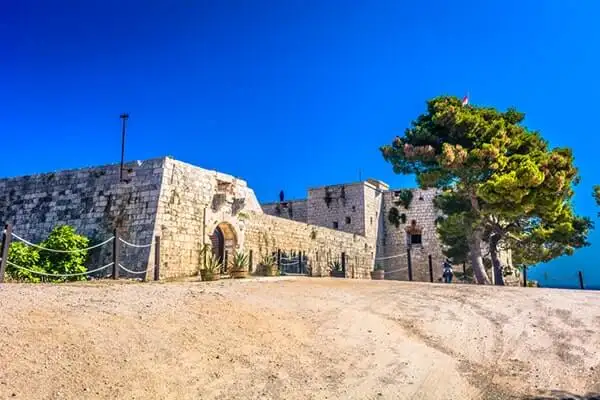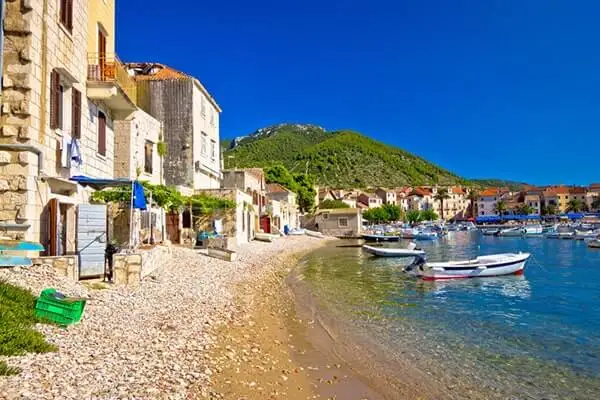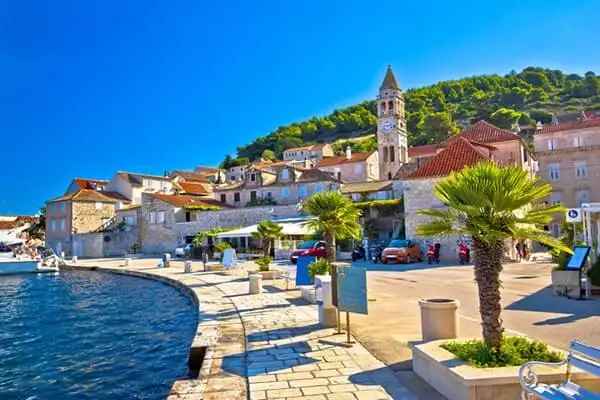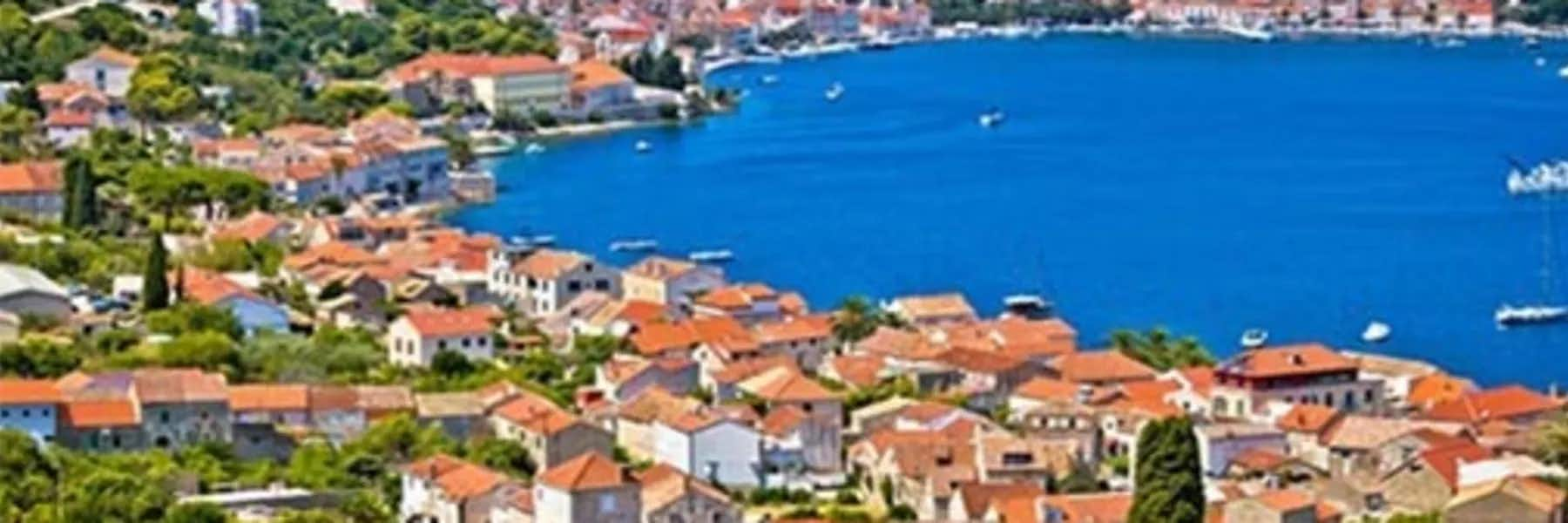Waves rolled and crashed along the bay’s rocky slopes. The steady roar would crescendo when the waves hit the breakwater, throwing a fine mist into the air.
Despite the thunderous cacophony, the waterfront town of Komiža was peaceful and quiet. It was late January on the Croatian island of Vis, and the tourist season was still a few months away.
A few year-round residents of the town could be seen going about their business. Otherwise, it was a serene place of white limestone and waves.
The low afternoon sunshine cut through the mist of the smashing waves, casting shadows of the palm trees that lined the waterfront. The temperature was a delightful 54 F for January and my wife, Tricia, and I decided to sit outside.
A single glass of wine stood on the table between us. The sun’s rays danced and dazzled in the golden liquid.
The grapes that made this wine were brought by the ancient Greeks over 2,000 years ago. Its name is Vugava and it is believed to be an ancestor to the more commonly known varietal, Viognier.
We were lucky to be on the island drinking it; 30 years ago, we may have been arrested.
The Mystery of Vis

The island of Vis is located about 38 miles off the mainland coast of Croatia. The only way to access the island is by a ferry crossing from the city of Split. The voyage usually takes about two-hours-and-twenty minutes.
Thirty years ago, you had to be a citizen of Yugoslavia and a resident of the island to take the ferry. Otherwise, you may have been arrested and treated as a spy.
The island of Vis was a secretive military fortress throughout much of the 20th century. While a few people were allowed to live on the island during this time, the Yugoslavian military prohibited visitors and kept the island shrouded in mystery.
Today, Vis is an open and thriving island in the center of the Adriatic Sea. The remnants of the military presence have been converted into tourist attractions. This includes coastal tunnels to hide submarines and a bomb shelter designed to help 200 people survive a nuclear war.
Despite the darker side of war and fortifications, the military presence on Vis did give the island a distinct positive advantage—preservation. Since the island was closed to the world for decades, it survived the tourist hordes that have already discovered the rest of coastal Croatia. As a result, it is still a natural and pristine place to visit or live.
The Beauty of Vis

The coast of Croatia, together with its over 1,200 islands, is arguably one of the most beautiful places on the planet. It has a vast and complex history that stretches back thousands of years. From the Republic of Venice and the Austro-Hungarian Empire, to the ancient Greeks and Romans, long lines of civilizations have left their mark. Today, preserved by its Yugoslavian military history, the island of Vis is a glimpse into the past.
We stayed on the west side of the island in the town of Komiža, where very comfortable apartments can be had for around $25 a night in the off-season.
Vis Town

On the eastern side of Vis is the town the island is named after—Vis. Formerly known as Issa, Vis was built around an incredible natural harbor. It was settled by the ancient Greeks in the fourth century BCE.
The town’s long history is reflected in a number of different structures. Ruins from the Greek presence include a defensive wall built around the city and a necropolis (cemetery).
You can find Croatia’s largest collection of Greek artifacts in the Vis Archaeological Museum. The treasures are kept in an Austro-Hungarian fortress built in the early 1800s.
The Romans acquired Vis in 47 BCE. With their emphasis on a high quality of life, the Romans built an elaborate bathhouse on the waterfront. The floors of the bathhouse were once covered in elaborate tiled mosaics. Today, archeologists are meticulously trying to restore them.
The Romans also built an outdoor theater for entertainment. However, this performance venue now lies underneath a church dedicated to Saint Jerome. The church, built in the early 1500s, has a unique semi-circular shape since it was built atop the arches of the theater.
Today, Vis is the island’s main ferry port with regular service to the city of Split. Split is Croatia’s second largest city and is the regional transportation hub for trains, planes, buses, and ferries. It is also the primary destination for healthcare services and shopping.
Things to See, Eat, and Do in Vis

Citrus
When we visited in the winter time, the citrus trees on Vis were ablaze with oranges and lemons. We must have missed the harvest by only a few days.
Once the locals pick the fresh fruit, they feast and sell what they can. Any leftover citrus is candied or made into jams and marmalades for the hot summer months. The locals will drizzle the delightful fruit spreads on fresh bread, cheese, or on thin Croatian pancakes called palačinke.
Carob
In addition to its bountiful citrus trees, Komiža is also known for its unique carob trees. These trees produce a brown pod full of sweet seeds. These seeds, when ground into a powder, can be used like chocolate. The powder then makes its way into a wide range of desserts on the island.
Carob trees come from the Middle East where the seeds (carats) were used to measure the weights of precious metals and stones. Brought to Vis by the ancient Greeks, the seeds from the trees around Komiža were a prized export for centuries.
In September, Komiža celebrates its carob history with a Carob Days festival. Here you can see how carob is processed and taste how it is added into sweet treats. You may even want to try rogačica, a brandy distilled from the prized seeds.
Fresh Fish
Due to its ideal location in the center of the Adriatic Sea, Komiža had a once thriving fishing industry. Large deep-water fish were caught off the coast and processed in one of seven factories in the small town.
Today, Komiža’s fish factories are closed and the era of intensive fishing is over. However, the town still celebrates its legacy every August on Fisherman’s Night, or Ribarska noć. Wood fires light up the night sky of the waterfront and a wide variety of fish are grilled over the open flames.
There is an expression along Croatia’s Dalmatian Coast. For a fish to be delicious, it must swim three times. First, it must swim in the sea. Second, it must swim in olive oil. Third, it must swim in wine.
In other words, good grilled fish must be accompanied by a glass of wine. On the island of Vis, that wine should be Vugava.
White Wine
Wine is an inextricable part of the landscape on Vis. Vineyards line the hills and are often separated by olive and carob trees. More than likely, the grapes hanging on those vines are Vugava.
Vugava grapes are packed with sugar. As a result, they can be made into wines with a high-alcohol content or into a sweet dessert wine called prošek.
The glass of Vugava that I enjoyed was crisp, refreshing, and had hints of quince and citrus. This could be a reflection of the other fruits grown on the island.
The Blue Cave
Vis is rich in natural beauty and attracts visitors from around the world. One of the main sites visitors clamor to see is the Blue Cave.
The Blue Cave is located about 5.6 miles off the coast of Komiža on the island of Biševo. It was once only accessible by holding your breath and diving down to an underwater hole in the rock. However, in 1884, an opening was carved at the surface to allow small boats to enter.
The cave has become incredibly popular in recent years due to the stunning blue-hue photos you’ll be able to take inside. However, plan well in advance if you want to visit; the lines can be long, the seas can be rough, and it can close unexpectedly.
Stiniva Beach
Another photogenic destination on Vis is the dramatic Stiniva Beach. Enclosed by limestone cliffs and accessible by a narrow gap leading out into the Adriatic Sea, this beach has become a magnet for tourists.
The beach, together with other Vis sites, was a filming location for the 2018 movie, Mamma Mia: Here We Go Again.
Due to its popularity, try visiting Stiniva Beach in the off-season or early in the morning to avoid the crowds.
The Takeaway
Vis is a worthwhile destination throughout the year. From its military past to its culinary delights, this island has something for everyone.
If you get a chance, try chatting with the locals. The residents of Vis are incredibly kind, generous, and they may just have a fascinating story to share about the island’s secretive past. Perhaps they’ll shed a little more light on this mysterious and beautiful destination.
Related Articles
The Best Places to Visit in Croatia 2020
Olive Groves, Pebbled Beaches, and Deep History in Brač, Croatia
